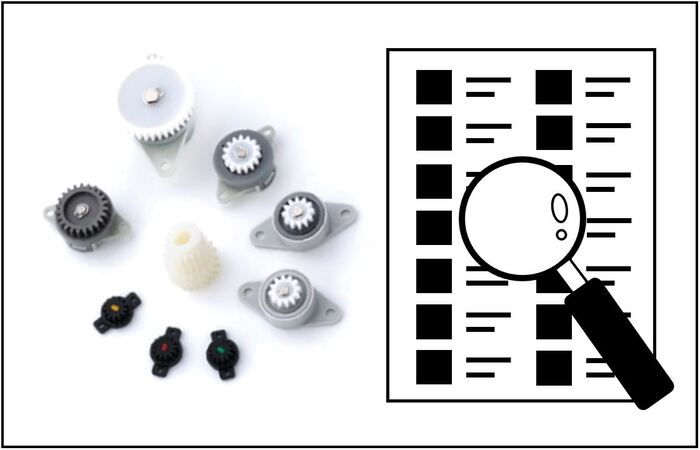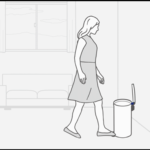
How do you select the best rotary damper when considering installing a rotary damper? The most important factor is torque, and when we receive an inquiry, we normally confirm or calculate the torque required for the rotary damper, and then expect the rotary damper which customers need and introduce it.
The torque calculation sheet available on the rotary damper website allows you to calculate the reference torque for selecting a rotary damper. Torque calculations can also be performed in cases where there is no actual unit at the design phase. There are two types of calculation methods, that is used an actual unit and design data.
In this article, we will show you how to calculate the torque required for a rotary damper and what you need to pay attention to after the calculation.
Contents
Rotary damper torque calculator that is measured an actual unit

If you already have the actual unit to be mounted, we recommend an easy way to calculate the torque by the maximum force to lift the lid and the length of the lid. You can automatically calculate the exact torque from this page.
There are various ways to close a lid, such as closing it horizontally, hanging down, or closing it at an angle, however, regardless of the way to close the lid, the force to support the lid is most required in the horizontal position. Therefore, when calculating torque, it is necessary to calculate the torque when the lid (or something object) is in the horizontal position.
You can feel that the force to lift the lid is maximum in the horizontal position when the lid is opened slowly with a tension gauge or push-pull gauge hooked to tip of the opening/closing part of the lid.
The torque calculation is multiplied by applying the pull-up force when the lid is horizontal (F in the figure), which is the maximum force to lift the lid, and the distance from the center of rotation when the rotary damper is installed to the position where the hook of the gauge was applied when the pull-up force of the lid (l in the figure) was measured.
Rotary damper torque calculator that is used a design data

If the prototype is not yet available at the design phase but you know the position of the center of gravity of the lid (or something object), the torque can be calculated from the weight of the lid and the position of the center of gravity. You can automatically calculate the exact torque from this page.
Even if the shape of the lid is complicated, if the lid is designed using 3D CAD, the position of the center of gravity can be figured out, so you can calculate the torque based on the distance from the center of rotation to the center of gravity and the weight of the lid.
If the lid shape is simple and you can design without 3D CAD, the reference torque can be calculated by considering the position of half the length of the lid as the center of gravity and multiplying the length of gravity position and the weight of the lid.
Even if you do not have the prototype, you also have to calculate the torque when coming to the horizontal position.
Important points when calculating the torque required for rotary dampers

You should be careful when the result of torque calculation is applied to choosing rotary damper. It is because the lid may twist during the lid close if the center of gravity of the lid is not in the center of its width.
Especially, the lid is heavy or not rigid, the lid may close with twisting if the center of gravity is not taken into account.
If the weight of the lid is light and the torque can be handled with only one rotary damper, it is better to install the rotary damper on the shaft support section to the center of gravity to prevent twisting when the lid is closed. If two rotary dampers are required because of the heavy weight of the lid, the torque calculation results are for two rotary dampers, so it is necessary to determine the torque for each by dividing the ratio according to the position of the center of gravity. For example, if the torque calculation result for mounting a rotary damper on a 300 mm wide lid is 6 N・m (30 kgf・cm) and the center of gravity of the lid is 50 mm off the center of width, the width direction ratio of the center of gravity position is 2:1. Therefore, the rotary damper closer to the center of gravity should be set at 4 N・m (40 kgf・cm), and the rotary damper farther from the center of gravity should be set at 2 N・m (20 kgf・cm) to close the lid with less twisting. Based on the calculated torque, it is important to consider the mounting position and torque according to the position of the center of gravity.
Summary of Rotary damper torque calculator | One point explanation
In this article, we have provided the following information on how to calculate the torque required for rotary dampers.
・There are two methods of torque calculation, which can be selected according to the situation.
・Calculate the torque by the weight of the lid in the horizontal position no matter how the lid is closed.
・When the center of gravity is different from the center of width, be careful about the rotary damper assembly position to prevent the lid from closing while twisting.
The above is how to calculate the torque required for rotary dampers and important points. After calculating the torque on our rotary damper website, enter the torque in the search bar at the top of the website page and search for the applicable rotary damper. If you cannot find the corresponding rotary damper, please feel free to contact us using this form so that we can find it for you or propose a customized product.
Related Articles
・Rotary damper torque auto-calculation
・Tips to determine a rotary damper torque
・Rotary Damper Torque Calculator | For Free Fall
・How to Amplify Torque with Gears When Rotary Damper Lacks Torque
Please wait until the contact form is indicated.
If you cannot find the contact form in spite of waiting, please let us know from this link.












